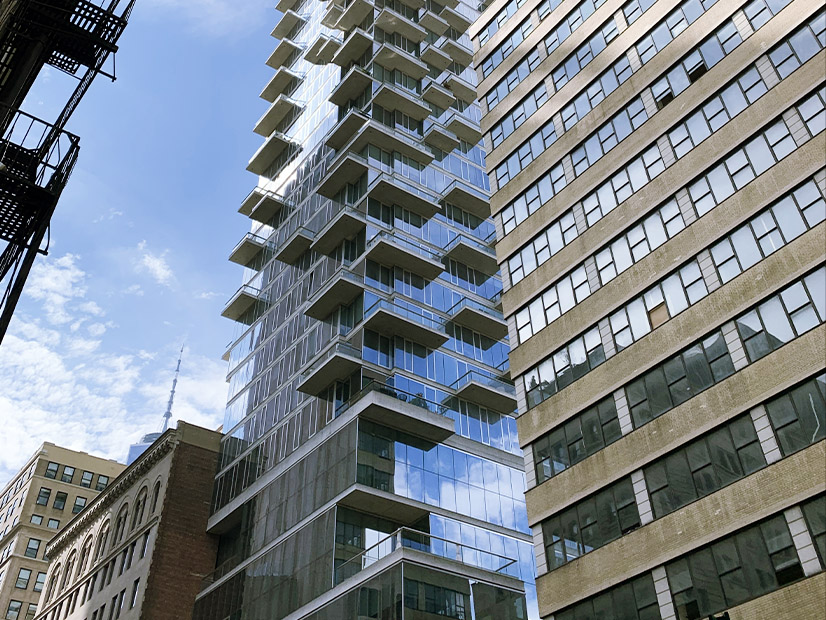
Alkemy Environmental is preparing to take the next step in its startup journey to commercialize an environmentally friendly concrete aggregate that can lower the carbon footprint of buildings.
“We hold patented technology for recycling industrial waste streams into structural-grade, lightweight concrete aggregates, which are essentially sand and gravel and make up 70% of your standard concrete mix,” Peter Kombouras, CEO of the Somerville, Mass.-based company, said Thursday.
Another 10% of the mix is cement, the production of which is responsible for the bulk of GHG emissions in the concrete industry. Alkemy’s product takes an indirect approach to addressing the carbon intensity of the industry, which accounts for 8% of global GHG emissions.
Through its participation in the Greentown Labs Healthy Buildings Challenge, Alkemy learned that its lightweight aggregate can play a key role in net-zero building design by reducing the load on a building, Kombouras said during a wrap-up event for the challenge.
Reducing a building’s weight means it needs less steel and concrete to reinforce it. And the sustainable aggregate, Kombouras said, lowers the building’s embodied carbon by extending the lifecycle of materials and reducing GHG emissions associated with industrial waste in landfills.
Alkemy can recycle industrial waste streams from plants for waste-to-energy, coal combustion, wastewater treatment, paper production and much more, Kombouras said. The resulting product, he said, is a green building material that meets LEED standards.
Sofia Bethanis, president and chief scientist at Alkemy, developed the waste-recycling solution while at Imperial College London.
“Discussions with our mentors [in the Healthy Buildings Challenge] broaden our vision about the potential applications of our technology and how it fits into sustainable building design and climate-resilient infrastructure,” Kombouras said.
The challenge is a Greentown Labs accelerator program for climate tech startups in partnership with French construction materials provider Saint-Gobain and supported by the Massachusetts Clean Energy Center.
“Buildings account for about half the energy used in the U.S. and about 40% of the carbon emissions,” Greentown Labs CEO Ryan Dings said at the event. “The diversity of the built environment means that we will need a multitude of solutions.”
Five startups participated in the program to discover how their products can support carbon neutrality for buildings. The program provided opportunities for the companies to identify the best avenues for product commercialization and to work with established partner companies with an eye for growth.
Alkemy came out of the program with a plan to work on pilot projects with Saint-Gobain to demonstrate the aggregate technology and potentially retrofit existing Saint-Gobain subsidiary lightweight aggregate plants.
Steel Alternative
InventWood joined the Healthy Buildings Challenge to find the best real-world application for its wood-based alternative to steel.
“We like to think of ourselves as wood alchemists, in that we’re able to transform the chemistry of wood to imbue it with incredible properties,” InventWood CEO Josh Cable said during the event.
While steel is a “wonderful material,” it has “meaningful challenges,” he said. About 7% of annual global GHG emissions are attributable to steel production. InventWood wants to help reduce those emissions with what it calls “metal wood,” an extremely strong material made through a process discovered at the University of Maryland.
Metal wood is made by taking a regular piece of wood and modifying it with a chemical treatment and putting it through a process that aligns the wood’s fibers. The result is a material that is as strong as many types of structural steel, but Cable said it’s 80% lighter and costs 50% less. It also has natural protection against fire, fungus and termites.
With the help of mentors in the buildings challenge, the College Park, Md.-based company identified an initial opportunity for the product and studied the environmental impacts of that application.
“We are planning to work with [Saint-Gobain subsidiary] CertainTeed to commercialize a cladding product that can be a game changer in the built environment,” Cable said. CertainTeed manufactures interior and exterior building products.
In addition to reducing the overall weight of a building, the cladding product will remain dimensionally stable in hot or cold weather. And the wood itself is a carbon dioxide sink, sequestering 1.5-2 kilograms of CO2 per one kilogram of wood.
Cable expects the company to deploy 170,000 cladding panels within two years and expand the product to other building construction applications.
Over the next 30 years, he said, the metal wood product has the potential to avoid 37.3 gigatons of CO2 emissions.
More Solutions
Three other startups completed the Greentown program.
AeroShield of Boston is working on a super-insulating, transparent insert for windows. The company received a National Science Foundation grant last year to research transparent silica aerogels to insulate glass.
Italy-based Enerbrain is developing a way to make heating, cooling and ventilation systems smarter through digital monitoring and control. And Zero, a Cambridge, Mass.-based software developer, wants to enable hassle-free home retrofits that improve comfort and eliminate emissions.

